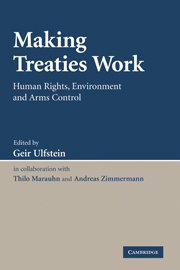Book contents
- Frontmatter
- Contents
- Preface and acknowledgments
- Notes on the contributors
- Table of cases
- Table of treaties and other international instruments
- INTRODUCTION
- PART I INTERNATIONAL HUMAN RIGHTS
- PART II INTERNATIONAL ENVIRONMENTAL LAW
- PART III INTERNATIONAL ARMS CONTROL
- 10 Dispute resolution, compliance control and enforcement of international arms control law
- 11 The Convention on the Prohibition of the Development, Production, Stockpiling and Use of Chemical Weapons and on their Destruction (Chemical Weapons Convention)
- 12 The Treaty on the Non-Proliferation of Nuclear Weapons (NPT) and the IAEA Safeguards Agreements
- 13 The Convention on the Prohibition of the Use, Stockpiling, Production and Transfer of Anti-Personnel Mines and on their Destruction (Ottawa Convention)
- GENERAL COMMENTS
- Index
12 - The Treaty on the Non-Proliferation of Nuclear Weapons (NPT) and the IAEA Safeguards Agreements
Published online by Cambridge University Press: 05 September 2009
- Frontmatter
- Contents
- Preface and acknowledgments
- Notes on the contributors
- Table of cases
- Table of treaties and other international instruments
- INTRODUCTION
- PART I INTERNATIONAL HUMAN RIGHTS
- PART II INTERNATIONAL ENVIRONMENTAL LAW
- PART III INTERNATIONAL ARMS CONTROL
- 10 Dispute resolution, compliance control and enforcement of international arms control law
- 11 The Convention on the Prohibition of the Development, Production, Stockpiling and Use of Chemical Weapons and on their Destruction (Chemical Weapons Convention)
- 12 The Treaty on the Non-Proliferation of Nuclear Weapons (NPT) and the IAEA Safeguards Agreements
- 13 The Convention on the Prohibition of the Use, Stockpiling, Production and Transfer of Anti-Personnel Mines and on their Destruction (Ottawa Convention)
- GENERAL COMMENTS
- Index
Summary
The International Atomic Energy Agency (the ‘IAEA’ or ‘Agency’) is an independent intergovernmental organization with a current membership of 139 States. It was created by the Statute of the IAEA, which was approved on 23 October 1956 by the Conference on the Statute of the IAEA, held at the headquarters of the United Nations, and entered into force on 29 July 1957.
The IAEA is headed by the Director General, and is composed of six Departments headed by Deputy Directors General and a Secretariat staff of some 2,300 individuals. The policy making organs of the IAEA are its Board of Governors and General Conference. The Board consists of thirty-five members, ten of whom are designated as the most advanced in the technology of atomic energy within geographically specified country groups. The others are elected to membership by the General Conference. The Board of Governors is authorized to carry out the functions of the Agency in accordance with the Statute, subject to its responsibilities to the General Conference. The General Conference of the IAEA consists of representatives of all Member States, and is convened annually, usually in September.
Although the IAEA is considered to be part of the United Nations common system, and, as a consequence, implements, and participates in the development of, administrative rules and practices for United Nations organizations, it is, formally speaking, not a body of the United Nations nor is it a specialized organization thereof.
- Type
- Chapter
- Information
- Making Treaties WorkHuman Rights, Environment and Arms Control, pp. 301 - 323Publisher: Cambridge University PressPrint publication year: 2007



